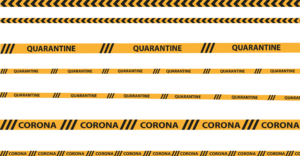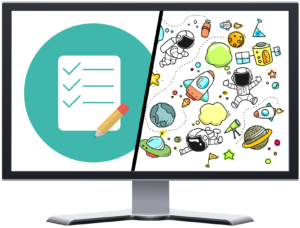That was one challenging year we left behind, but the problems that emerged in 2020 didn’t magically evaporate on the day we set foot into the new year. Those challenges are still here, so let’s face them and find some immediate solutions that digital signage software can provide.
While some of these problems emerged fairly recently, such as occupancy tracking, others have hounded many businesses who opted to invest in digital signage for a long time. We start with the fresher of the problems first, and work our way through those resilient ones which have been around for years!
1. Weak occupancy tracking
Rewind the clock by a year, and if you told someone that occupancy tracking would be an important factor in everyday operations of a 2021 business, nobody would believe you. Yet here we are, and keeping track of how many people are present at any given business location is more important than ever.
First, remind people of the occupancy rate when entering your establishment. Second, track the numbers and limit access based on the occupancy rate. In fact, digital signage can do more than just show the numbers. Intertwined with additional tech, digital signage can actually prevent automated doors from opening until the occupancy rate is at the desired level.
2. An uninviting environment
This is another problem that’s been sadly enhanced by the recent pandemic. Establishments have become visually uninviting for visitors. Not necessarily because of the physical appearance of the establishment itself, but the constant reminder of the tough time we live in. While we all understand the importance of wearing a mask, seeing a plethora of dry, monotonous PSAs littering every store entrance does make the situation feel a bit grim. Especially since most of those paper PSAs haven’t had an update in months and have started shedding and peeling off. Quite exciting, isn’t it?
Yes, indeed you can use digital signage as a perfect replacement for paper PSAs—primarily since digital signage won’t shed and is actually appealing to look at. Apart from PSAs, putting digital signage in your storefronts alongside them can counteract the rather depressive reminder through comic or uplifting relief. Digital signage has always been an exciting sight, and that note of positivity is needed now more than ever. Get some exciting content to your storefront! Try with a cartoon, a fun social media post, or at the very least an inspiring message.
3. Inefficient content management
Digital signage can be a mood-influencing addition to any establishment. But it requires regular updates and good management. You need to keep the content fresh and interesting. Content creation is on its own time consuming, as is the scheduling and updating. Digital signage software can help in almost every aspect of this problem.
Managing your content turns into a breeze. The majority of time will be spent on setting up the schedules and presets. As long as you have content to show, digital signage software will make sure it’s shown at the right time. You can organize content in campaigns, playlists. Also, if you want to broadcast menus, pricing, and announcements, you don’t need to design them from scratch. You can simply input the data into a template, tweak the color scheme and visuals a bit, and you’re done. For other types of content, use apps to dynamically display data you’d want to share. For example, you can use apps for news feeds, social media, weather and more!
You can also schedule content in such a way that it is triggered by certain events. This includes geofence triggering, ideal for digital signage that is on the move. When there is nothing else to show, or if a campaign fails for some reason, a fallback campaign will step in. For instance, if someone deletes campaign files on accident, there will still be something to show. The viewer will never know!
4. Stale and unexciting content
Repetition of content can be a very boring sight. In fact, repeating anything over and over again gets dull quickly. Nevertheless, repetition is okay to a certain degree.
You can pre-set your daily offers and just have them rotate throughout the week. You can even do this on offers or content that changes throughout the day. Take care of it all automatically! Which components of your content will change regularly throughout the day/week? Apply that to this context. For instance, you may want to have a custom greeting message for each day. You can set up greetings to rotate on a weekly basis, unique to each day of the week. The greatest challenge with clever repetition of content is timing. Fortunately, with digital signage software, you could quite literally plan out your content schedule a year in advance!
That is one clever plan, in fact. Set up a rotating schedule for each day, so there is always something timely. Whenever you want to display a special campaign or offer, digital signage software allows you to interrupt the current rotation of content to do it! Once that’s done, the content rotation resumes.
5. A lack of content
The biggest misconception when it comes to digital signage is the belief that it requires little to no work. It just runs itself! “Yeah, it’s quite effortless really. All I need to do is whip up a menu, some visuals from pexels.com or something, put it to rotate, and I’m set for the week! The customers will love it!”
The saying “the grass is always greener on the other side of the fence” comes to mind as people often invest in digital signage and assume it will be a self-sustaining tool. But then they invest and quickly learn that creating content is a far greater task than it first appeared. Well, creating GOOD content is, at the very least. This isn’t meant to scare you away from digital signage, merely to keep you grounded and aware that, just like any other good marketing tool, it needs to be taken seriously. Digital signage software can be of tremendous help in creating content.
Let’s take a look at the two main divisions of your content. On one side, you have your business-related content such as pricing, offers, advertising, product instructions etc. Let’s label this your primary content category. Digital signage software can provide you with templates which only need you to input your data. You can always tweak these templates, but they’re ready to go! No hassle about designing a layout, setting up a table or hiring someone to design it for you. This isn’t to say there’s anything wrong with that, but in case you want to roll out content ASAP, this is the way to do it ASAP.
On the other side, you have your non-business-related content such as entertainment, cartoons, fun facts, greetings, custom messages: all with the intent to bond with the customer. Let’s label this your secondary or auxiliary content category. It’s the small talk of your content. One could even label it filler content, i.e. it fills all the gaps left between your primary content components. Digital signage software, such as OnSign TV can provide filler content via pre-created inspirational quotes, RSS feeds, and even a plethora of fun facts. One category that’s ideal for anyone on any day of the year is the Today in History content feed.
6. The challenges of content management
As we’ve by now covered all sides of content management to fully grasp what it entails, it is clear just how important a good management interface is. Digital signage software acts as that interface, allowing you to have a clear overview of how, when, and where your content is displayed.
When asking what the perfect digital signage software solution for your needs is, know that you’re asking a question with more than one answer. Some software providers are ideal for giants with hundreds of displays to manage and unique customization needs, while others might fit smaller businesses better. Here at OnSign TV we show you the features and advantages our software offers. Get in touch with our sales time to talk about your specific requirements. Whichever way you decide to go, the following features should be your primary guide when searching for your digital signage software of choice:
- An easy editing layout
- Flexible scheduling
- Proof of play reports
- A comprehensive dashboard
- Player grouping
- User access complexity
Read more on these features to see what they entail and why they’re relevant to you as a user. Some may appear irrelevant at first, but you’ll see them become fantastic problem-solvers later down the road. Feel free to experiment with the above mentioned features, and plenty more, with a free 14-day OnSign TV trial. No credit card required!











